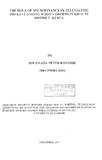| dc.description.abstract | Microfinance is the provision of financial services to low income clients, including consumers and the self employed; who traditionally lack access to banking and related services. The development of microfinance in Kenya started with K-Rep Bank, heavily modeled on the Grameen Bank model, in 1984. According to the MFI Report (2010), there are currently over 43 microfinance institutions in Kenya under the umbrella of the Association of Microfinance Institutions of Kenya (AMFI), serving over 6,000,000 poor people. AMFI is now a self sustaining association of microfinance organizations in Kenya, and has supported the enactment to law in 2007: the Microfinance Act and the attendant Prudential Microfinance Regulations under the supervision of the Central Bank of Kenya. The overall objective of this study was to document the role of microfinance in alleviating poverty among women groups in Kisauni district, Kenya. To achieve the above objective, a survey was conducted and data collected by use of structured questionnaire that was administered to respondents who willingly shared relevant information. Stratified sampling was used to sample MFI women group beneficiaries and factor analysis was used to analyze the data. The study established that most of the women beneficiaries of MFIs had some significant change in their lives, from lives that were full of struggles to lives that were decent and able to meet their basic needs. They had gone through some kind of training which equipped them with some relevant business skills although most of those who participated in the study were of the view that regular trainings would enable provide them with the much needed business skills. Further, most women acknowledged that the loans they had accessed from MFIs had helped them improve their standard of living but confessed that the interest rates were still high and unfavourable and the loan repayment conditions were strict leading to some women losing their assets (collateral) through repossession by the MFI(s) for lack of servicing their loans and the inability to manage their businesses. The study recommends that the government needs to establish a policy that would regulate the interest rates charged by the MFIs in order to enable the poorest of the poor maximize on the small loans so as to break away from the vicious cycle of poverty. Also further research should be carried out to explore the role of government, banks or NGOs that focus on poverty alleviation in enabling women become more financially stable and pull themselves out of the vicious cycle of poverty. | en_US |


